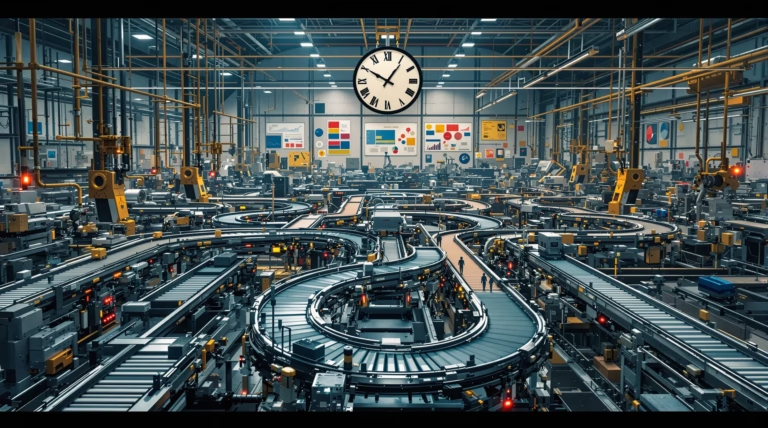Manufacturing Execution System: A Comprehensive Guide
In today’s rapidly evolving manufacturing landscape, efficient production management is crucial for maintaining competitiveness. Manufacturing Execution Systems (MES) have emerged as a game-changing solution, revolutionizing how manufacturers control, optimize, and monitor their production processes. Let’s explore how MES transforms manufacturing operations and delivers tangible business value.
Understanding Manufacturing Execution Systems (MES)
Manufacturing Execution Systems serve as the critical bridge between planning systems and shop floor operations in modern manufacturing environments. These sophisticated software solutions track, document, and control the transformation of raw materials into finished products, offering real-time visibility and control over the entire production process. Unlike traditional manufacturing management approaches, MES provides instant access to production data, enabling quick decision-making and continuous process improvement.
As manufacturing becomes increasingly complex and competitive, MES solutions have evolved from simple production tracking tools into comprehensive platforms that optimize operations across multiple dimensions. By connecting machines, systems, and personnel in a unified digital ecosystem, MES empowers manufacturers to respond rapidly to changing market demands while maintaining strict quality controls and operational efficiency.
What is a Manufacturing Execution System?
A Manufacturing Execution System (MES) is a computerized platform that monitors, tracks, and manages production processes on the factory floor in real time. Acting as the operational nerve center of manufacturing facilities, MES fills the crucial gap between enterprise resource planning (ERP) systems and shop floor automation. It provides manufacturers with moment-by-moment insights into production activities, enabling them to make data-driven decisions that optimize output, quality, and cost parameters.
At its core, MES captures and analyzes data from equipment, operators, materials, and processes throughout the production lifecycle. This real-time monitoring capability allows plant managers to visualize production status, identify bottlenecks, and implement immediate corrective actions. Rather than relying on end-of-shift reports or weekly summaries, MES delivers actionable intelligence when it matters most—during actual production—making it an indispensable tool for modern manufacturing operations seeking to maximize efficiency and maintain competitive advantage.
Key Features of MES
- Production Scheduling – Advanced algorithms for optimal resource allocation and sequencing
- Data Collection and Analysis – Automated gathering and real-time analysis of production data
- Inventory Management – Real-time tracking of material movements and consumption
- Document Control – Centralized management of work instructions and procedures
- Equipment Monitoring – Continuous tracking of machine performance and maintenance needs
- Quality Management – Enforcement of inspection protocols and quality standards
- Product Traceability – Complete documentation from raw materials to finished goods
Benefits of Implementing MES
| Benefit Category | Impact |
|---|---|
| Production Efficiency | 10-20% increase through elimination of non-value-added activities |
| Labor Productivity | Significant improvement through streamlined processes and reduced paperwork |
| Material Waste | Substantial reduction through precise inventory control |
| Regulatory Compliance | Automated documentation and audit trails for FDA, ISO requirements |
| ROI Timeline | Typically 6-18 months |
Integration and Deployment of MES
Manufacturing Execution Systems deliver maximum value when seamlessly integrated into an organization’s existing technology infrastructure. This integration creates a cohesive digital ecosystem where information flows freely between different layers of the manufacturing operation—from shop floor automation to enterprise-level planning systems. Properly deployed MES solutions serve as the operational bridge connecting high-level business systems with real-time production activities, enabling manufacturers to synchronize planning with execution and respond dynamically to changing conditions.
Modern MES deployment approaches have evolved significantly, with organizations now having options beyond traditional on-premises installations. The emergence of cloud-based MES solutions has transformed the accessibility, scalability, and cost structure of manufacturing execution systems, making advanced production management capabilities available to manufacturers of all sizes. These deployment options allow companies to select implementation strategies that align with their specific operational requirements, IT resources, and business objectives while maintaining the core benefits of real-time production visibility and control.
Integrating MES with ERP and SCADA
Effective MES integration creates bidirectional communication between enterprise resource planning (ERP) systems, manufacturing execution systems, and supervisory control and data acquisition (SCADA) platforms. This interconnected architecture enables seamless information flow where production plans from ERP cascade down to MES for execution, while actual production data from SCADA and shop floor systems feed back through MES to ERP for accurate business reporting.
- Information Flow Benefits – elimination of data silos and manual entry
- Real-time Updates – consistent, up-to-date information across all systems
- Decision Support – timely insights for fast-paced manufacturing environments
- Automated Adjustments – dynamic inventory updates based on actual consumption
- Production Optimization – schedules that reflect real floor conditions
From a technical perspective, MES-ERP integration utilizes standardized protocols and middleware for system communication. Modern approaches leverage OPC UA, web services, and API connectors to establish reliable data exchange. The MES-SCADA integration creates a comprehensive operational technology layer that combines machine-level control with production management, providing complete visibility from individual equipment performance to factory-wide efficiency metrics.
Cloud-Based MES Solutions
| Feature | Benefit |
|---|---|
| Remote Access | Production monitoring from any location with internet connectivity |
| Scalability | Easy system expansion without significant IT infrastructure investment |
| Maintenance | Reduced burden through specialized service provider support |
| Implementation | Faster deployment and more frequent feature updates |
| Cost Structure | Lower upfront capital expenditure |
Cloud-based Manufacturing Execution Systems represent a significant evolution in manufacturing technology deployment. These systems leverage cloud computing infrastructure to deliver MES functionality through secure internet connections, eliminating extensive local hardware requirements. This deployment model enables distributed operations and facilitates collaboration across multiple sites while allowing manufacturing organizations to focus on their core competencies rather than IT management.
Advanced Technologies in MES
The evolution of Manufacturing Execution Systems has accelerated dramatically with the integration of advanced technologies that transform traditional manufacturing environments into smart factories. Modern MES platforms leverage interconnected digital technologies to create unprecedented levels of automation, visibility, and intelligence across production operations. These technological advancements enable manufacturers to move beyond basic production tracking toward predictive and adaptive manufacturing models that respond to changing conditions in real-time.
Role of IIoT in MES
The Industrial Internet of Things (IIoT) serves as the foundation of modern MES implementations, creating a network of connected devices and sensors that generate continuous data streams from every aspect of the production environment. This connectivity layer enables granular, real-time operational data collection from machinery, environmental systems, tools, materials, and personnel movements across the factory floor.
- Data Collection – thousands of data points captured per second
- Equipment Communication – direct instruction transmission to smart machines
- Automated Workflow – intelligent material handling and routing
- Quality Control – immediate defect detection and correction
- Process Integration – seamless translation of digital designs to physical production
AI and Machine Learning in MES
Artificial intelligence and machine learning capabilities are transforming MES functionality through autonomous decision-making and predictive capabilities. Modern AI-powered MES solutions analyze vast production datasets to identify patterns, anomalies, and optimization opportunities beyond human capability. These systems continuously evolve through historical and real-time data analysis, improving their prediction accuracy and recommendations over time.
- Pattern Recognition – analysis of thousands of production runs for optimal parameter settings
- Automated Adjustments – real-time modification of processing parameters
- Quality Prediction – early detection and prevention of potential issues
- Production Scheduling – dynamic rescheduling during disruptions
- Inventory Optimization – demand-based stock level management
| Predictive Maintenance Impact | Performance Improvement |
|---|---|
| Maintenance Cost Reduction | 15-25% |
| Machine Downtime Decrease | 30-50% |
MES in Various Industries
Manufacturing Execution Systems have evolved to address specific requirements across diverse industrial sectors, incorporating specialized functionalities for unique regulatory landscapes and production challenges. While maintaining core real-time monitoring and optimization principles, MES solutions adapt significantly based on industry-specific demands, enabling manufacturers to achieve operational excellence while ensuring strict compliance.
MES in Pharmaceuticals and Biotechnology
In pharmaceuticals and biotechnology, MES platforms serve as critical tools for maintaining regulatory compliance while optimizing complex production processes. These systems incorporate essential features for FDA, EMA, and global health authority requirements:
- Compliance Features – electronic batch records, automated audit trails, 21 CFR Part 11 compliance
- Production Controls – precise material weighing, complex recipe management
- Quality Assurance – real-time parameter monitoring, automated deviation management
- Biologics Support – cell culture optimization, advanced environmental monitoring
- Validation Tools – cleaning validation, process verification systems
MES in Food and Beverage
Food and beverage manufacturers utilize MES to address unique quality control demands and regulatory requirements. These specialized systems provide comprehensive tracking capabilities for ingredient traceability and compliance with FSMA, HACCP, and global food safety regulations.
- Quality Monitoring – temperature, pH levels, cooking times tracking
- Safety Features – vision systems for contamination detection, automated sampling
- Production Management – recipe variations, allergen control protocols
- Inventory Control – shelf-life monitoring, perishable material management
- Compliance Tools – automated documentation, recall management systems
MES in Aerospace and Defense
Manufacturing Execution Systems in aerospace and defense industries manage complex assembly operations while maintaining strict military and aviation safety standards. These specialized MES platforms address unique sector challenges through comprehensive tracking and control mechanisms.
- Component Management – complete genealogy tracking of thousands of parts, serial numbers, and revision levels
- Production Timeline Control – management of multi-year assembly processes with detailed documentation
- Safety Compliance – automated tracking for service bulletins and safety directives affecting specific batches
- Assembly Guidance – 3D visualization-based work instructions for complex operations
- Quality Assurance – torque sequence enforcement, tool calibration validation, inspection documentation
Measuring Success with MES
Manufacturing Execution Systems transform operational data into actionable intelligence through precise performance metrics and data-driven analysis. This systematic approach replaces subjective assessments with objective measurements, enabling manufacturers to identify improvement opportunities and validate enhancement initiatives.
| Strategic Benefits | Operational Impact |
|---|---|
| Real-time decision making | Improved capital investment planning |
| Resource optimization | Enhanced market responsiveness |
| Standardized KPIs | Cross-departmental alignment |
Tracking Overall Equipment Effectiveness (OEE)
Overall Equipment Effectiveness serves as manufacturing’s premier metric for production efficiency evaluation, combining three critical components: availability, performance, and quality. MES platforms automate OEE calculations through real-time equipment data collection, providing immediate visibility into productive time utilization.
- Availability Analysis – tracking of downtime events by duration, frequency, and root cause
- Performance Monitoring – identification of micro-stops and speed reductions
- Quality Assessment – correlation of defects with process conditions and materials
- Impact Analysis – prioritization of improvement initiatives based on data
- Trend Evaluation – historical performance tracking for continuous improvement
Analyzing Production Performance
Modern MES platforms leverage advanced analytics to transform operational data into strategic insights. These systems monitor thousands of production parameters continuously, creating comprehensive digital records of manufacturing performance. Through sophisticated visualization tools, complex data sets become intuitive dashboards that reveal hidden trends and correlations.
- Comparative Analysis – evaluation across shifts, lines, and facilities
- Process Optimization – correlation of variables with quality outcomes
- Capacity Planning – accurate forecasting based on historical trends
- Performance Tracking – real-time monitoring of critical parameters
- Decision Support – data-driven insights for operational improvements




